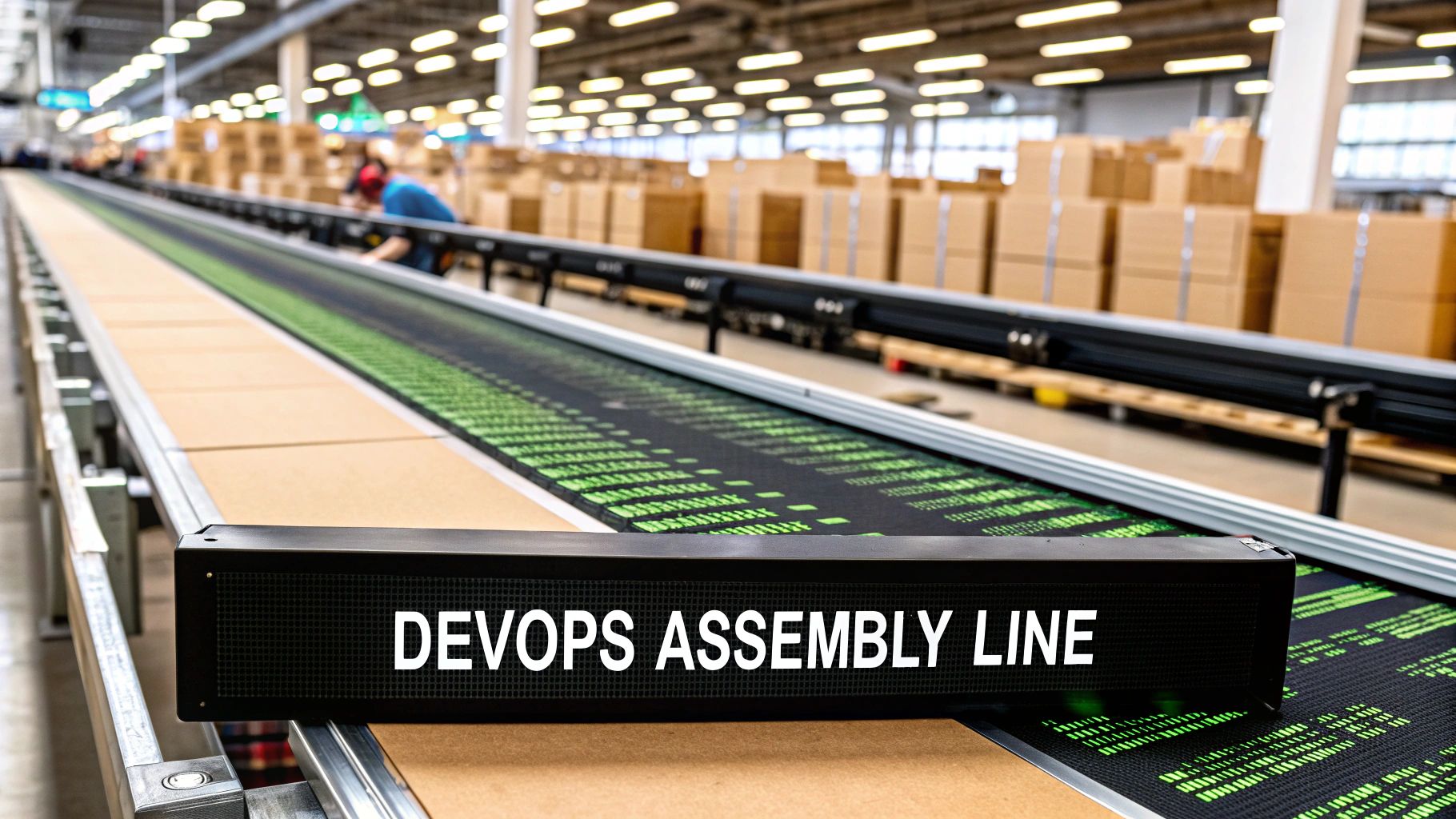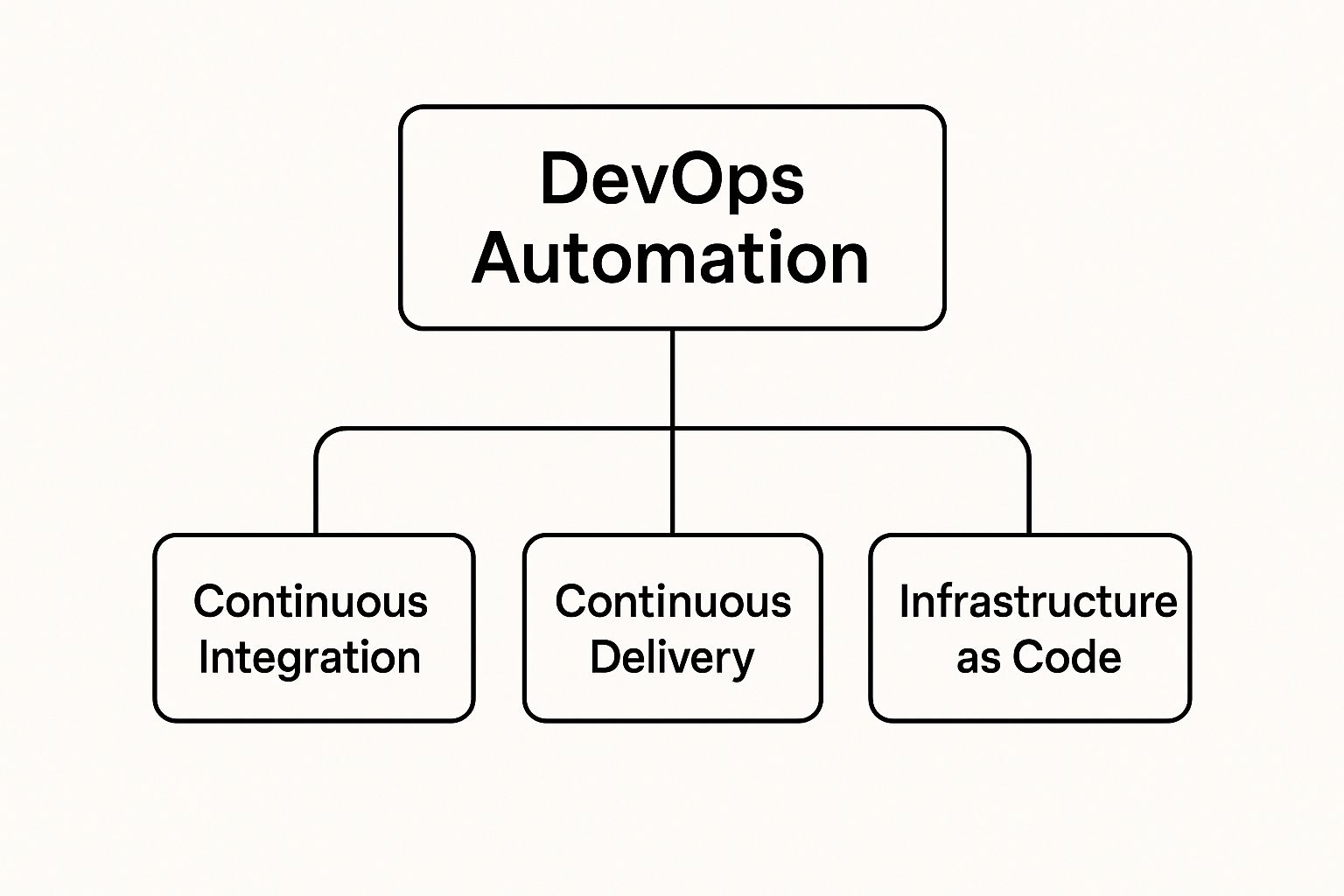What is DevOps Automation? Unlock Faster Software Delivery
Learn what is DevOps automation, how it boosts efficiency, and why it’s vital for modern development. Discover the key concepts now!

Think of DevOps automation as the ultimate assembly line for building software. It’s a way of using technology to handle all the repetitive tasks involved in software development and IT operations, so humans don't have to. This connects everything—from writing code to testing it and pushing it live—into a single, smooth, and incredibly fast system.
The biggest win? It gets rid of tedious manual work and slashes the chances of human error.
Decoding DevOps Automation

When people ask, "What is DevOps automation?", they're really asking how to fix the classic disconnect between the people who build the software (Dev) and the people who run it (Ops). Instead of tossing work over a wall from one team to the other, automation builds a bridge. It creates a unified workflow that takes code from a developer’s machine to a live server quickly and, most importantly, reliably.
But this isn't just about plugging in a few new tools. It's a fundamental shift in how teams work. The real goal is to build a system that practically runs itself, freeing up your teams to collaborate and ship better software, faster. It helps to have a good handle on the broader concept of automation to see the full picture.
You can see just how important this has become by looking at the market numbers. The DevOps market in the United States alone hit USD 2.7 billion in 2024 and is expected to rocket to USD 16.9 billion by 2033. A huge driver behind this growth is the move to hybrid cloud setups, which are almost impossible to manage without solid automation in place. You can dive deeper into the market data with these DevOps trends and forecasts.
The Automated Pipeline: How It All Works
The automated pipeline is the heart of DevOps. It’s a series of stages, each kicking off the next one automatically, taking code from idea to reality without anyone needing to step in manually.
Here's a breakdown of the core components that make up a modern DevOps pipeline.
| Core Components of a DevOps Automation Pipeline | | :--- | :--- | :--- | | Component | Primary Goal | Example Tools | | Continuous Integration (CI) | Merge code changes frequently and automatically build/test them to find bugs fast. | Jenkins, GitLab CI, CircleCI | | Continuous Delivery/Deployment (CD) | Automatically prepare and deploy tested code to production or staging environments. | Argo CD, Spinnaker, Octopus Deploy | | Infrastructure as Code (IaC) | Define and manage infrastructure (servers, networks) through code for consistency. | Terraform, Ansible, AWS CloudFormation | | Continuous Monitoring | Automatically track application performance and health in real-time to catch issues. | Prometheus, Datadog, New Relic |
Each of these components plays a critical role. When they're all working together, you get a system that not only moves faster but is also far more reliable and predictable.
By automating these key stages, teams can focus on innovation instead of getting bogged down by repetitive, error-prone tasks. It turns the complex process of software delivery into a predictable, efficient, and scalable operation.
Why DevOps Automation Is a Competitive Advantage
So, you know what DevOps automation is. But why does it matter so much? Simply put, it's how modern companies build a serious competitive edge. Businesses that get automation right don't just work faster; they work smarter. The result is better products and happier customers.
This isn't just about being "more efficient." We're talking about real, measurable improvements in three critical areas: speed, reliability, and security. By automating the tedious, repetitive parts of software delivery, you can shift from being slow and reactive to fast and forward-thinking.
Accelerate Your Time to Market
In today's world, speed is the name of the game. DevOps automation can take the time required to move an idea from a developer’s screen to a user’s hands from weeks down to a matter of hours. This isn’t about cutting corners; it’s about eliminating the manual hand-offs and waiting periods that bog everything down.
When your team can confidently push out updates multiple times a day, the business becomes incredibly agile. You can respond to customer feedback or market shifts almost in real-time. This ability to iterate quickly lets you out-maneuver competitors, test new concepts with less risk, and grab market share while others are still in planning meetings.
Enhance Application Reliability and Quality
Shipping fast is pointless if the product is buggy and unreliable. This is where automation delivers its second huge win: rock-solid reliability. The secret ingredient is automated testing. Instead of relying on manual spot-checks, which are bound to miss things, automated tests run against every single code change.
This constant feedback loop catches bugs and regressions the moment they're introduced—when they're still small, cheap, and easy to fix. A stable, smooth-running application means a better experience for your users, which in turn leads to higher retention and a stronger brand. You can dig deeper into the various software quality assurance processes that automation makes possible.
Fortify Security from the Start
Historically, security was often the last-minute checkpoint before a release, frequently leading to painful delays and rework. DevOps automation completely changes that dynamic by weaving security into the entire development process from day one. This practice is known as DevSecOps.
This "shift left" approach means security isn't an afterthought; it's a constant. Automated tools scan code for vulnerabilities as it’s being written, check for known risks in third-party libraries, and validate that infrastructure is configured securely. A key part of this continuous improvement cycle involves optimizing work patterns through data transparency. By building security into every automated step, you create a much more resilient application, protecting your business and your customers without slowing down your release cadence.
The Core Practices Driving DevOps Automation
DevOps automation isn’t some magic button you press. It’s more like a finely tuned engine, built from several core practices that all work together. When you get them humming in unison, they create a seamless pipeline that takes an idea from a developer's mind and puts it into the hands of your users.
Let's break down these key components. Think of them as the pillars holding up your entire automation strategy. Each one solves a specific, classic bottleneck that used to grind software delivery to a halt.

As you can see, practices like Continuous Integration, Continuous Delivery, and Infrastructure as Code are the real foundation. They're what make a robust automation culture possible.
Continuous Integration: Your Code Quality Gatekeeper
First up is Continuous Integration (CI). This is your first line of defense against bugs and "merge hell."
Picture a team of developers, all hammering away on different features. In the old days, they'd work in isolation for weeks, and then try to merge all that code together. It was a nightmare of conflicts and hidden bugs.
CI changes the game. Every time a developer commits a small piece of code, an automated process kicks in. It grabs the new code, builds the entire application, and runs a whole suite of tests—all in a matter of minutes. If something breaks, the team knows immediately. This means problems are caught when they're small and easy to fix, not weeks later when they've become a tangled mess. For a deeper dive, check out these Continuous Integration best practices.
Continuous Delivery: The Automated Release Machine
Once your code passes all the CI checks, it’s ready for the next step: Continuous Delivery (or Continuous Deployment). This is the machinery that gets your tested code out the door.
There's a subtle but important difference between the two:
- Continuous Delivery means every change that passes the tests is automatically packaged and ready to be deployed. It gets pushed to a staging environment, but a human has to give the final "go" to release it to customers.
- Continuous Deployment takes it one step further. It's the full-throttle version where every single change that passes all the automated checks is pushed directly to production, without any manual intervention.
Either way, you've created a reliable, low-risk path to production. It turns stressful, all-hands-on-deck release nights into a boring, predictable non-event. And in DevOps, boring is good.
Infrastructure as Code: Your Server Blueprint
Next, we have Infrastructure as Code (IaC), which tackles one of the most frustrating problems in software: inconsistent environments. It’s the ultimate fix for the classic "well, it worked on my machine!" excuse.
In the past, servers were set up manually. An engineer would log in, install software, tweak configuration files... and maybe forget a step. The result? The staging server was just a little bit different from the production server, causing bizarre, hard-to-diagnose bugs.
With IaC, you write down the exact specification for your servers, networks, and databases in a code file. This file acts like a blueprint. Need a new environment? Just run the code. You get a perfect, identical copy every single time. Your infrastructure becomes as predictable and version-controlled as your application code.
Continuous Monitoring: Your Eyes and Ears in Production
Finally, just because your code is live doesn't mean the job is done. That’s where Continuous Monitoring comes in. It’s the vigilant guard that watches over your application 24/7.
Automated tools keep a constant eye on application performance, error rates, server health, and the overall user experience. If something goes wrong—an error spikes or response times slow down—alerts are sent back to the team instantly.
This creates a tight feedback loop, allowing engineers to jump on problems and fix them, often before most users even notice there was an issue. It’s what makes the whole automated system trustworthy and sustainable.
How to Choose Your DevOps Automation Tools

Picking the right tools is a huge step, but the sheer number of options out there can be paralyzing. The secret is to stop thinking about brand names and start focusing on capabilities. Don't get lost in an endless list; instead, let's group the tools by the job they actually do.
Your real goal is to build a toolchain. Think of it as a set of integrated tools that work together to automate your software delivery process from the first line of code to the final deployment. This isn't just a niche idea; the global market for these tools is expected to explode from roughly US$ 14.44 billion in 2025 to US$ 72.81 billion by 2032. You can learn more about the staggering growth of the DevOps automation tools market to see just how critical this has become.
Let’s break down the major categories.
CI/CD and Pipeline Orchestration
These tools are the conductors of your automation orchestra. They’re responsible for managing the entire workflow—kicking off builds, running automated tests, and pushing out deployments. They are the glue that holds everything together.
- Jenkins: This is the classic, open-source workhorse. Its main strength is a massive plugin ecosystem, which means you can make it talk to just about any other tool you can imagine.
- GitLab CI/CD: If you want a more all-in-one feel, GitLab is a great choice. It tightly combines your source code management with your CI/CD pipelines in a single, unified platform.
Infrastructure as Code (IaC)
Think of IaC tools as the blueprints for your entire infrastructure. They let you define servers, networks, and databases right in your code. This means every environment is consistent, repeatable, and version-controlled, which kills off those frustrating "it works on my machine" issues caused by manual configuration errors.
- Terraform: A huge advantage of Terraform is that it's cloud-agnostic. You can use the same code and workflow to manage your infrastructure whether you're on AWS, Azure, Google Cloud, or all three.
- Ansible: People often use Ansible for configuration management—making sure software is installed and set up correctly on servers that are already running. But it's also perfectly capable of provisioning new infrastructure from scratch.
Containerization and Orchestration
Containers neatly solve the "it worked on my machine" problem by bundling your application and all of its dependencies into a single, portable package. Orchestration tools take it from there, managing these containers at scale and automatically handling things like deployment, scaling, and networking.
- Docker: This is the de facto standard for creating and running containers. It makes packaging an application so simple that you can move it between development, testing, and production environments without a hitch.
- Kubernetes: Known as K8s, this is the undisputed leader for container orchestration. It automates the heavy lifting of managing containerized apps, making sure they stay resilient and can scale up or down as needed.
Your toolchain shouldn't be a random collection of popular software. It must be a carefully selected set of technologies that solves your specific bottlenecks and supports your team's workflow.
Seeing how these tools fit into clear categories is the first step toward building a toolchain that actually works for you. To make this even clearer, here's a quick breakdown of some popular options.
Popular DevOps Automation Tools by Category
| Tool Category | Popular Tool | Primary Use Case |
|---|---|---|
| CI/CD Orchestration | Jenkins | Automating the build, test, and deployment pipeline with extensive plugin support. |
| CI/CD Orchestration | GitLab CI/CD | Providing an all-in-one platform for source code management and CI/CD. |
| Infrastructure as Code | Terraform | Provisioning and managing cloud infrastructure declaratively across multiple providers. |
| Infrastructure as Code | Ansible | Automating application deployment, configuration management, and orchestration. |
| Containerization | Docker | Packaging applications and their dependencies into lightweight, portable containers. |
| Container Orchestration | Kubernetes | Managing, scaling, and deploying containerized applications automatically. |
Each tool in this table plays a specific role, but their true power is unlocked when they work together in a seamless, automated chain.
Your First Steps in Adopting DevOps Automation

Jumping into DevOps automation isn't about flipping a switch overnight. It’s a journey, not a destination, and trying to automate everything at once is a classic recipe for disaster. You'll just end up overwhelming your team and grinding progress to a halt.
The secret? Start small, prove the value, and then expand from there.
This phased approach keeps the transition manageable and, more importantly, delivers tangible results quickly. Instead of a massive, high-risk overhaul, you’ll be creating a series of small, confident wins that lay the groundwork for a real automation culture.
Phase 1: Start with a Single Project
First things first, you need to pick the right candidate for a pilot project. Resist the temptation to go for your most complex, mission-critical application. That’s a high-stakes gamble. Instead, choose a single, lower-risk project where your team can experiment and learn without the constant fear of major disruptions.
Once you’ve got your project, don’t try to automate the entire pipeline right away. Just focus on one area that creates the most friction or requires the most mind-numbing manual work. For most teams, the best place to start is with Continuous Integration (CI).
Automate just the build and test process. This single step delivers immediate value:
- You'll catch bugs much earlier. Every single code commit gets tested automatically, slashing the number of defects that slip through to later stages.
- Your developers will thank you. They no longer have to run tests by hand and get instant feedback on their changes, letting them focus on what they do best.
- It builds confidence. The team gets a clear, quick win that shows them firsthand what DevOps automation is capable of.
Phase 2: Expand to Deployment and Infrastructure
Once your team has CI down and is seeing the benefits, it's time to push further. The logical next step is bringing in Continuous Delivery (CD) to automate the release process. This means every code change that passes the CI stage is automatically prepped and pushed to a staging environment.
This step cuts down on even more manual handoffs, making your release process predictable and repeatable. After that, you can introduce Infrastructure as Code (IaC). Using a tool like Terraform to define your server configurations in code ensures your environments are perfectly consistent, every single time.
The goal is to create a virtuous cycle. Each successful automation step builds momentum and gives your team the confidence and skills to tackle the next phase. It turns a daunting transformation into a series of achievable goals.
Phase 3: Cultivate a Culture of Improvement
At the end of the day, the tools are only part of the story. True DevOps automation thrives on a cultural shift where teams are empowered to collaborate and constantly look for ways to improve. This means tearing down the traditional walls between development and operations.
Encourage your teams to share ownership of the entire software lifecycle. When developers understand the operational impact of their code and the ops team is involved early in development, you create an incredibly powerful feedback loop. You can learn more about how to design and implement these workflows by exploring different automation services.
This collaborative mindset is the real engine that drives lasting success.
What's Next for Automation in DevOps?
The world of DevOps automation never stands still. We're constantly chasing more speed, better efficiency, and smarter systems. The next big leap isn't just about making our pipelines faster—it's about making them more intelligent and self-healing. We're on the cusp of some exciting changes that will fundamentally reshape how we automate software delivery.
This evolution is driven by widespread adoption. DevOps isn't just for startups anymore. By 2025, it's projected that a staggering 80% to 81% of organizations will have adopted DevOps practices. And what's more, 99% of them are already seeing a positive impact. If you want to dive deeper into the numbers, Baytech Consulting has a great breakdown of global DevOps adoption.
The Trends Defining Tomorrow's Automation
So, what does this future actually look like? Three major trends are leading the charge.
-
GitOps: Think of this as making your Git repository the ultimate source of truth—not just for your code, but for your entire infrastructure. Every change, from a feature update to a server configuration, is handled through a pull request. This approach creates a completely transparent, auditable, and automated workflow.
-
AIOps: This is where we start injecting real intelligence into our operations. AIOps uses artificial intelligence to get ahead of problems. It can predict system failures before they happen, sift through mountains of performance data to pinpoint bottlenecks, and even kick off automated fixes without any human intervention.
-
Platform Engineering: The core idea here is to build an internal developer platform (IDP) that makes life easier for your development teams. It’s all about creating self-service tools and pre-built, automated workflows. This way, any developer can tap into powerful automation without needing to be a DevOps guru themselves.
Got Questions About DevOps Automation?
We've covered a lot of ground, so let's tie it all together. Here are some quick answers to the questions that come up most often when people are digging into DevOps automation.
Agile vs. DevOps vs. CI/CD: What's the Difference?
It’s incredibly common to see these terms used interchangeably, but they each play a distinct role. The easiest way to think about it is like building a high-performance race car.
-
Agile is the blueprint and project plan. It’s the philosophy of building the car in small, fast cycles—or sprints—so you can get feedback quickly and adjust the design as you go.
-
DevOps is the culture of the entire racing team. It’s getting the designers, mechanics, and drivers (your developers, operations, and QA folks) to work as one cohesive unit, communicating constantly and sharing responsibility for the car's performance.
-
CI/CD is the automated assembly line and pit stop. These are the powerful tools and automated processes that build, test, and deploy every new part onto the car, making the whole process incredibly fast and reliable.
Is DevOps Automation Just for Big Companies?
Not at all. While you often hear about huge companies using automation to manage massive systems, the truth is that startups and smaller businesses can see some of the biggest benefits.
Think about it: when you're a small team, every hour counts. Setting up a simple, automated build-and-test pipeline with a tool like GitLab CI/CD can free up your developers from tedious manual tasks.
Starting with automation early on is like building your company on a solid foundation. It prevents bad habits and technical debt from creeping in, setting you up to scale smoothly without hitting a wall.
How Can We Tell if Our Automation Efforts Are Working?
You'll definitely feel the difference, but you need to measure it to know for sure. Success isn't just about speed; it's about tracking specific, concrete metrics that prove you're moving in the right direction.
Two of the most critical metrics to watch are:
-
Deployment Frequency: How often are you pushing new code into the hands of your users? High-performing teams often deploy multiple times per day, not just once every few weeks.
-
Mean Time to Recovery (MTTR): When something inevitably breaks, how fast can you fix it and get the system back online? Solid automation can slash this time from a frantic few hours to just a few minutes.
These aren't just vanity numbers. They give you a clear, data-backed picture of how agile and resilient your team has become.
Ready to stop wrestling with manual deployments and build a seamless, automated workflow? The expert teams at 42 Coffee Cups specialize in implementing DevOps practices that accelerate your time-to-market and reduce development costs. Get in touch to build your high-performance web application.